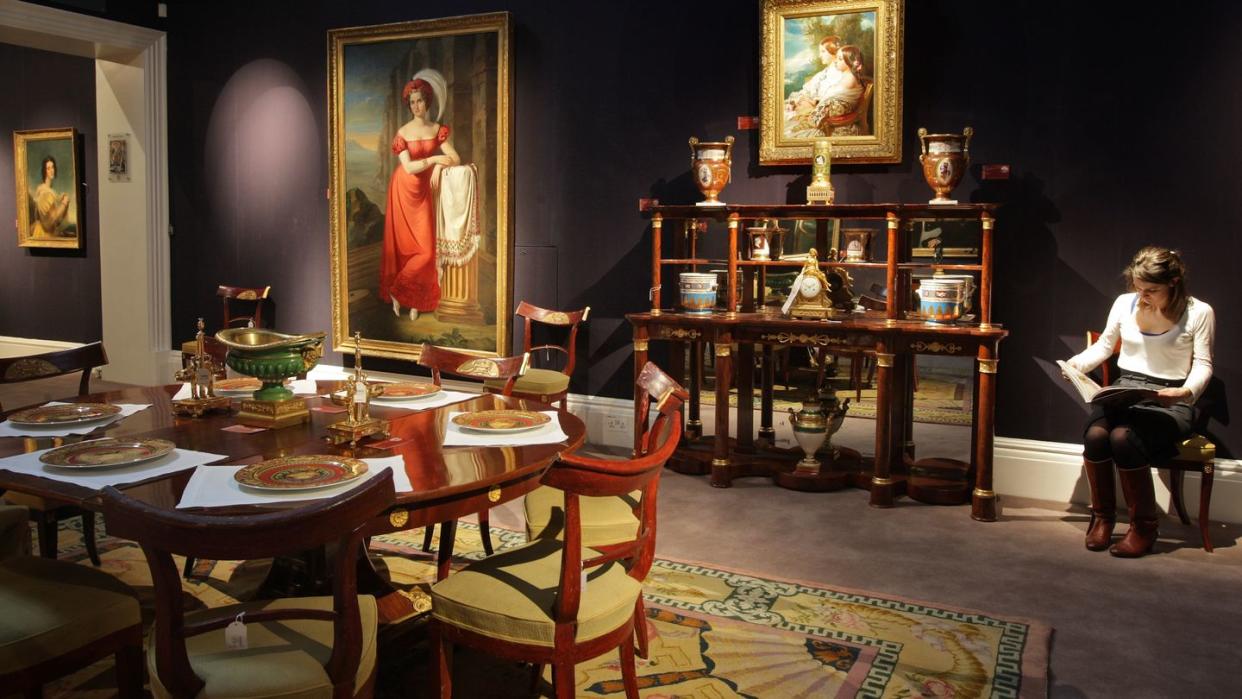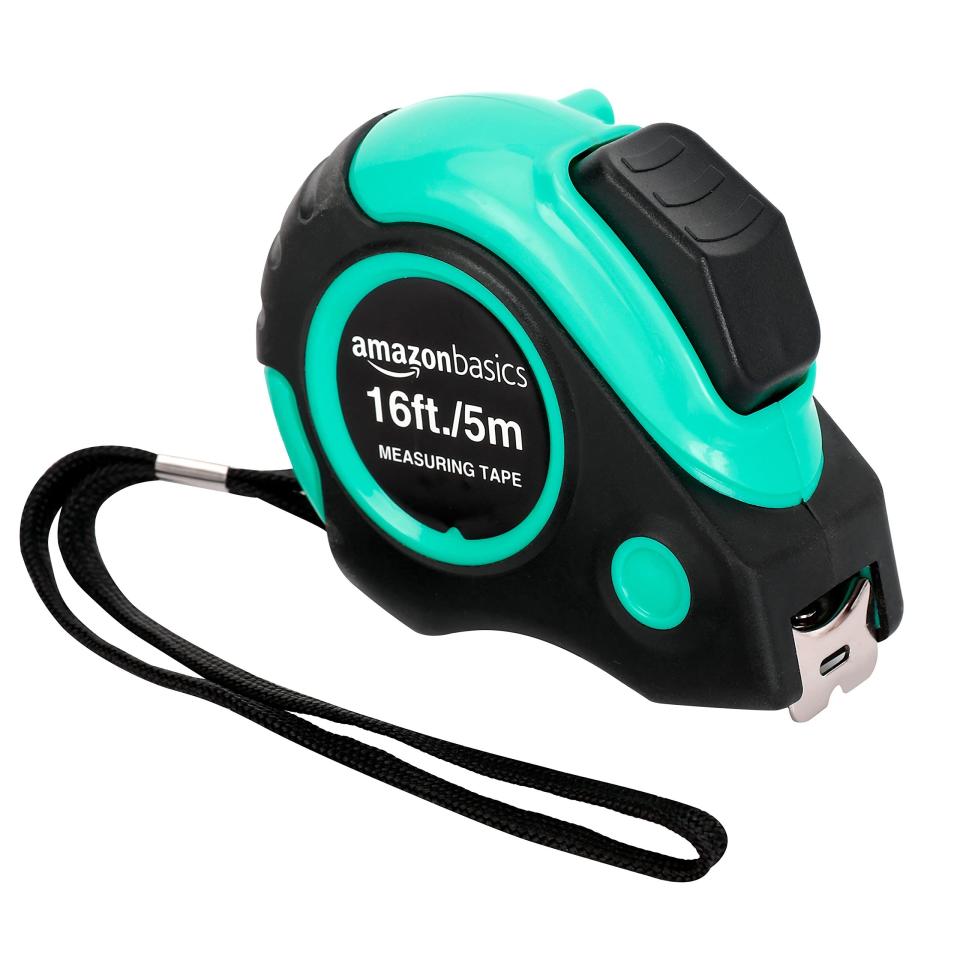How to Buy Furniture at Auction, According to Experts

"Hearst Magazines and Yahoo may earn commission or revenue on some items through these links."
As the auctioneer shouts dollar amounts, you raise your paddle in the air and your adrenaline flows. “Going once…going twice…sold!” Those magic words mean that you’ve won that Chippendale chair you’ve been eyeing, and now you get to take it home.
Although attending an in-person auction can be exhilarating (especially after you've brushed up on these auction etiquette tips), you don’t always have to go to the auction house to win such valuable antique pieces. Now you can shop auction websites from the comfort of your home and have a similar experience. No matter how you shop, auctions can be great places to score amazing antique and vintage furniture finds.
“Sometimes you can get a great deal at an auction!” says Alex Bass, Founder and CEO of Art Advisory & Interior Design Studio Salon 21. “I got our conversation pit sofa from 1stDibs by winning an auction that not a lot of people were bidding on. I was certainly able to acquire the piece for less than I would have at a store.”
Ashley Avrea Cathey, founder and principal of design firm Avrea and Company, loves the accessibility and ease of online auctions. She says, “With most auction houses online, it’s simple to search for anything you can think of, and if it’s out there, you can bid on it.”
Lindsey Owen, fine art and antique appraiser, ISA CAPP, says that many auction houses research pieces that can shed light on the provenance, style and period, making it easier to find exactly what you are looking for versus at a flea market or antique store, “which can be a bit more of a treasure hunt.” In other words? Auctions can be time-savers if you know exactly what you want.
We’ve broken down our experts’ best tips into online auctions and in-person auctions so you can be ready to win some furniture that will become instant heirlooms in your home.
How to Stop Online Auctions
1. Head to the best sites.
While eBay, 1stDibs, and Everything But The House are always tried-and-true options for online auctions, Avrea Cathey points out that conveniently, there are “database sites” like LiveAuctioneers.com and Invaluable.com that compile most auctions around the world into one site, which can save you time.
2. Search smarter.
You can search in real time for a specific furniture piece or maker through these websites, but even more wisely, you can save searches so that the website will alert you when certain items become available.
“I add specific items and artists that I love into the website’s ‘saved’ feature, and when they come up at auction, they notify you by email,” Avrea Cathey says. “It’s a great way to be alerted so you don’t need to search all the time when things are not available.”
3. View completed sales for similar pieces.
Owen says that on most aggregated auction websites, you can view completed sales for similar pieces.
“Simply type in your search terms and then select ‘Price Results’ or ‘Past Items’,” she says. “Then, sort the results so that the most recently sold items are at the top of your results. Many auction houses also list past sales results on their websites.”
Owen says that using this actualized sales data can be incredibly informative for your bidding strategy. “Similarly, you can use the same process to see how many bids were received on the lots, which can predict the type of competition you may expect when bidding,” she says.
4. Get educated.
This tip can be applied to both online and in-person auctions: Always do your homework when it comes to vintage and antique furniture.
“Knowing the different periods, styles, makers, materials, and construction techniques is invaluable to be able to identify quality pieces and set a bidding strategy,” Owen says. “For example, being able to discern ‘good, better and best’ will help you understand why one mahogany tea table sold for $15,000 while another mahogany tea table sold for $1,300.”
To pick up some helpful info, Owen says that there are many online and print resources available, but “my favorite way to become acquainted with period furniture is to see it in person,” she says. “Historic house museums are the best way to do this as you can see period pieces within the environment they were created for.”
How to Shop in-Person Auctions
1. Know an auction house’s specialties.
“While most auction houses will have diverse offerings, they can specialize in different types of items,” Owen says. “Therefore, it can be helpful to know which auction houses sell what well.” Seek out auction houses who particularly specialize in antique and vintage furniture, or the period you’re most interested in.
2. Consider the location.
Although the thrill of the hunt is always exciting at an auction, reality may set in when you realize you have to figure out how to get that giant furniture piece home.
“Regionality can be key when trying to acquire a particular style or piece of furniture, for largely logistical reasons,” Owen says. “Furniture can be big, heavy, and difficult to move, therefore you can usually still find pieces fairly close to where they were made or where the styles were particularly popular.”
If you’re looking for convenience, find out the key pieces that are well known in your region of the country, which can make getting a piece home easier. For instance, Owen says that if she’s looking for Southern Federal period furniture, then she would be looking at Brunk Auctions or Leland Little, both out of North Carolina.
But perhaps you’re willing to pay shipping if you’re at an auction house far from home. Avrea Cathey says that you should keep freight and shipping fees in mind when making these purchases. Also, she says that it’s “important to have a local shipper lined up and possibly get a quote for larger items beforehand.”
3. Pay attention to how pieces are catalogued.
“Pay close attention to how pieces are cataloged,” Owen says. “For example, an American-made piece which is labeled William and Mary would indicate a period piece from approximately 1700-1720, however, a piece labeled William and Mary Style would likely be from a later period, as we see revivals of previous styles frequently in the 19th century.”
4. Utilize previews.
For in-person auctions, Owen says that you should make the most of previews to inspect for condition and reference the condition notes from the catalog.
“A good rule of thumb is to review all the photos and measurements, and even ask for more,” Avrea Cathey says. “And always confirm the measurements work in your space. There is nothing worse than buying something too small or too big. I will hold a tape measure up to the walls near items I am considering to be sure.”

Amazon Basics Tape Measure, 16 Ft.
amazon.com
$9.83
5. Set a budget.
“When buying at auction, you can get carried away with the bidding process—it's easy and addictive,” Avrea Cathey cautions. “So, it’s best to have a price you're willing to pay in your mind before starting, plus remember there is an auction house fee and shipping involved on top of the winning bid.”
6. Be aware of extra fees.
Speaking of those fees you perhaps weren’t expecting, Owen says that it’s important to make yourself aware of any post-sale fees and logistics.
“You will most likely be charged a buyer’s premium, which is an industry standard practice. However, the percentages charged vary from auction house to auction house,” she says. “The buyer’s premium can be anywhere from 15 percent to 35 percent of the hammer price, with most auction houses falling between 20 percent to 30 percent.”
Owen also recommends making yourself fully aware of the transport policies, as they can vary between auction houses. She says, “Some places will be full-service and will arrange the transport of your pieces for an additional fee. On the other hand, some auction houses will provide pick-up windows and refer you to third-party movers.”
What Furniture to Look for at Auction
Even though you might have a penchant for certain furniture pieces or time periods, maybe you’re still not sure what to be on the lookout for at auctions.
Bass says that it can simply be “anything you really have your eye on or a designer whose work you haven't been able to acquire because of a high price point.”
In general, Owen says that these choices at auctions are always “going to be subjective to the buyer and their style and priorities,” but she does add, “across the board, high-quality pieces in good condition will always be a smart move.”
“Always buy what you like,” Owen concludes. “At the end of the day, the antique market is just that—a market. Values will fluctuate, and if they happen to dip, then you will still have a piece that you enjoy.”
You Might Also Like

